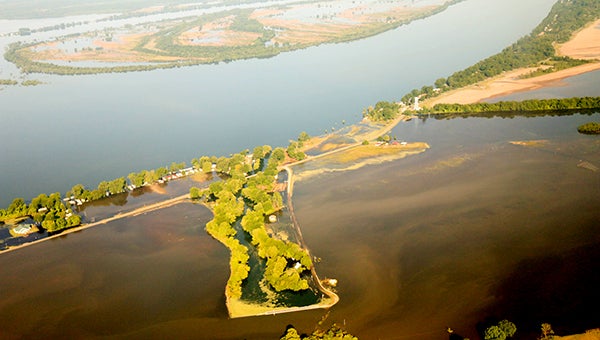EPA does not object to proposed backwater pumps project
Published 9:01 am Thursday, December 3, 2020

- An aerial photograph of flooding in the Eagle Lake area taken in July 2019. (Walter Frazier/ The Vicksburg Post)
The Environmental Protection Agency has given its blessing to the Yazoo Backwater Pumps Project.
According to a letter — dated Monday — from EPA Region 4 Director Mary Walker to Col. Robert Hilliard, commander of the U.S. Army Corps of Engineers Vicksburg District, the EPA has determined the proposed project is not subject to EPA’s 2008 Final Determination, which vetoed a similar project.
The proposed plan to install pumps in the Deer Creek area, included in recent reports by the U.S. Army Corps of Engineers, is not the same plan once vetoed by the EPA and thus can proceed without the agency’s objection.
“The purpose of the Yazoo Pumps Project is to alleviate flooding in the Yazoo Backwater Area, an approximately 630,000-acre area situated between the Mississippi and Yazoo Rivers in west-central Mississippi,” Walker wrote. “The EPA fully supports the purpose of the project to reduce flood damages in the Yazoo Backwater Area.”
In 2019, the Yazoo Backwater Area suffered a historic, months-long flood that inundated thousands of acres of farmland and destroyed homes throughout the region, including the Eagle Lake community.
Walker said in the letter the District’s 2020 Draft Supplemental Environmental Impact Statement “provides information and analysis regarding a similar but different Yazoo Pumps Project than was previously analyzed.
“It also provides new information on the project’s potential environmental impacts to wetlands, endangered species, fish and wildlife, water quality, downstream areas, and environmental justice populations,” Walker wrote.
The pump station was the final piece of the Yazoo Backwater Project authorized by Congress in 1941. The major piece of the project was the Yazoo Backwater Levee, completed in 1978. The EPA vetoed the pumps project in 2008.
The pumps are expected to move 14,000 cubic feet of water per second from the land or Delta side of the structure to the river side if and when the Steele Bayou Control Structure gates are closed due to high river stages.
Designs had it protecting about 630,000 acres in the South Delta from flooding. Flooding to residential and non-residential structures in the Delta would be reduced by 68 percent when the pump station is completed, according to a report from the Corps.
The project took on new life during the devastating flood in 2019 and is the subject of a lawsuit against the U.S. asking the courts compel the Corps to build the pumps and seeking compensation for residents and property owners affected by the flood.
Flooding in the Yazoo Backwater area covered land in the Delta for 219 days and reached a record level of 98.2 feet during the 2019 flood, covering 548,000 total acres of land including 231,000 acres of cropland.
The flooding inundated the Eagle Lake community, forcing many residents there to leave their homes and evacuate to other areas. The water also overtopped Mississippi 465, Mississippi 16 and Mississippi 1.
Many of the backwater residents and local officials blamed the EPA’s decision to veto the construction of the pump station, which was to be built on the Steele Bayou Control Structure to help protect the South Delta from flooding.
According to the suit, “Inclusion of the pumping system was necessary to the Yazoo Backwater Project for periods when events of heavy rainwater coincide with high flood stages along the Mississippi River. In this situation, without the pumps, the Yazoo Basin essentially becomes a bathtub with no effective drainage mechanism.”
The suit claims the design, construction, and subsequent operation of the Yazoo Backwater Project and the Steele Bayou Control Structure by the Corps “resulted in the direct, natural and foreseeable flooding of Plaintiffs’ property.” Routing the drainage of the entire Yazoo Basin to the Steele Bayou Control Structure, the suit continued, “Created a massive pool of water for which there was no drain.”
Had the Yazoo been able to drain naturally or the pumps been installed or natural drainage routes been built, according to the suit, “The current flooding and taking of plaintiff’s property would not have occurred.”
The plaintiffs would have been better off and the flooding not occurred “with no intervention from the defendant,” the suit claims, adding without the Backwater Project, “the floodwater would have continued to drain naturally into the Yazoo River.”






